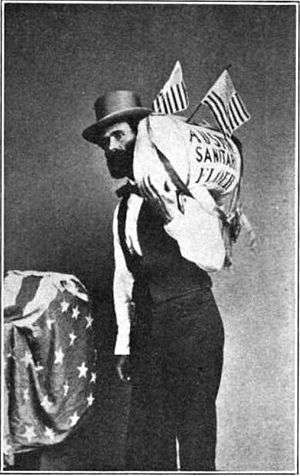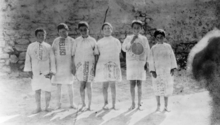Flour sack
A flour sack, feed sack, or flour bag is a cloth sack, usually made of cheap cotton, used to store flour or animal feed. Flour sacks are often printed with simple designs and trademarks to indicate the millers and companies making or selling the flour. Many regions of the world reuse the sacks to produce clothing and household linens.

Place names
Various place names were named after flour sacks, since they were so ubiquitous in so many cultures. Blatobulgium in Scotland, and Pieniężno in Poland, for example, are possibly named after words for flour sack in different languages. The all-white tower in the old city of Ravensburg in Germany is called Mehlsack.
Reuel Colt Gridley

Reuel Colt Gridley famously carried a 50-pound bag of flour on his shoulder after losing a political bet in Austin, Nevada. The sack of flour was later auctioned off, then re-donated, then re-auctioned again and again to raise money for the United States Sanitary Commission during the American Civil War. Auctioning this single flour sack eventually raised more than $250,000.
Clothing
.png)

Because they came along with the purchase of essential flour, flour sacks were universally recycled and used by many cultures as a source of free textiles for clothing and other necessities. For refugees, the free cloth that came with flour helped replace worn-out and inadequate clothing.
In the US
By the middle of the 19th century in the US, the economies of shipping commodities such as animal feeds, seeds, sugar and flour became more cost-effective to package and ship in sacks rather than in barrels, which was what had been previously used.[1] By the late 19th century, flour sacks were often printed in various colors and designs, and recycled for clothing and other purposes. Farm women recycled the sacks into clothing, and by 1925 at least one company, Gingham Girl, was packaging in dress-quality fabrics and using their sacks as a selling point.[1] By the 1930s companies regarded the sacks as a crucial part of marketing product.[1] One feed store owner complained about purchase decisions moving from the farmer to the farmwife, saying "Years ago they used to ask for all sorts of feeds. Now they come over and ask me if I have an egg mash in a flowered percale. It ain’t natural.”[1]
During the Great Depression in the US, many families sewed clothing from discarded flour sacks. Often flour would be purchased according to the patterns printed on the bag.[2] The sacks had so many uses, and the clothing made from them was so common, that flour sacks entered the local folklore. Kendra Brandes found that "as an element of material culture, the clothing and clothing practices of rural populations reflect the life and times of the era to the same extent as that of the general population. However, it is the activities of these farm wives, clothing their families in feed sacks, that offer a view of life that was unique to rural communities during this time period."[3]
Several people from rural Virginia spoke about their clothes made from sacks during the depression. "Back then, feed was sold in sacks. I believe they held almost 100 pounds of seeds. A number of farmers who didn't sew returned the sacks for resale... I actually made hair bows, pants and dresses from the sacks." "Mama always sewed on a Singer treadle sewing machine and made our dresses from flour sacks. She made sure Dad would get two sacks just alike. That was what the pattern took to make the dresses right." "Mama made me pinafores out of flour sacks. Flour sacks were made of cotton with pretty prints." "Dresses made for my sister and me were sometimes made out of cotton feed bags (I guess my brothers were lucky)." "My mother made shirts out of feed sacks, which a lot of cow feed, came in."[4]
An estimated 3.5 million women and children wore flour sack clothing during the Great Depression. It just became a way of life, as times were very hard.[5]
According to the Smithsonian, "With feed sacks and flour bags, farmwomen took thriftiness to new heights of creativity, transforming the humble bags into dresses, underwear, towels, curtains, quilts, and other household necessities."[6]
In China
During the early parts of the 20th century, Chinese workers made clothing from flour sacks, sometimes called "Hunger clothes".[7] A photograph from 1948 shows school children wearing uniforms made of United Nations Relief and Rehabilitation Administration flour sacks.[8]
In Europe
In Europe, flour sacks were used in clothing, quilts, coats and strainers.[9]
Folklore
Feedsacks and flour sacks were also used to make rag dolls and doll quilts for children.[10]
See also
- Gunny sack (the potato sack)
- Plastic shopping bag
- Sackcloth
- Commission for Relief in Belgium § Flour bags
References
- Onion, Rebecca (2017-07-21). "How Depression-Era Women Made Dresses Out of Chicken Feed". Slate Magazine. Retrieved 2020-03-20.
- Banning, Jennifer Lynn. "Feed Sack Fashions in South Louisiana, 1949–1968: The Use of Commodity Bags in Garment Construction." Baton Rouge, La.: Louisiana State University, 2005.
- Brandes, Kendra (2009-01-01). "Feed Sack Fashion in Rural America: A Reflection of Culture". Online Journal of Rural Research & Policy. 4 (1). doi:10.4148/ojrrp.v4i1.59. ISSN 1936-0487.
- Blair, Todd, and Karen Garvey. Flour Sack Dresses and Victory Stamps: Tales from the Good Old Days in Roanoke and the New River Valley of Virginia: a Treasury of 20th Century Memories. 2016. Pages 63, 117, 134, 161, 208.
- "History of Flour Sack Towels - from 1800's to 1950's [sic]". Mary's Kitchen flour sack towels.
- "Feedsack Dress". National Museum of American History. Retrieved 2020-03-20.
- Unidentified. Man wearing pants made out of a flour sack, China, c. 1905 – 1910. University of Southern California. Libraries, 1904.
- Glass, Fr. Floyd. Children in Guilin, China, 1948. University of Southern California. Libraries, n.d.
- Shaw-Smith, David, Conor McAnally, Jolyon Jackson, and Sally Shaw-Smith. Irish Patchwork. 2003.
- Nixon, Gloria. Rag Darlings: Dolls from the Feedsack Era. Kansas City Star Quilts, 2015.
Bibliography
- Bi-Folkal Productions. Sewing Savings: Feed & Flour Sacks. Madison, WI: Bi-Folkal Productions, 2000.
- Brinkman, Marilyn Salzl. Aprons, Flour Sacks & Other Folk Histories. St. Cloud, Minn: Sentinel Printing, 2008.
- Fieguth, Joyce. Flour Sacks and Binder Twine. Belleville, Ont: Epic Press, 2003.
- Glazer, Mark. Flour from Another Sack & Other Proverbs, Folk Beliefs, Tales, Riddles & Recipes. Edinburg, Tx: Pan American University, 1982.
- EDGE, JOHN T. The New Encyclopedia of Southern Culture Volume 7: Foodways. Chapel Hill: The University of North Carolina Press, 2014.
- Meunier, Christiane. A Few of My Favorite Feedsack Quilts. Montrose, PA: Moon Over Mountain, 2006.
- Nixon, Gloria. Feedsack Secrets: Fashion from Hard Times. Kansas City, Mo: Kansas City Star Books, 2010.
- Oikawa, Saeco. アメリカンヴィンテージファブリック : アメリカで集めた, とっておきの布= Amerikan vintēji faburīkku: Amerika de atsumeta, totteoki no nuno = Vintage fabric from the states. T̄ōkyō: PIE Books, 2005.
- Shaw-Smith, David, Conor McAnally, Jolyon Jackson, and Sally Shaw-Smith. Irish Patchwork. 2003. Includes County Wicklow and County Down quilts "...and others sewn by thrifty women from used flour sacks and old overcoats."
- Zimmerman, Darlene. Chicken Linen: Feedsack Facts and Projects. Fairfax, MN: Needlings, Inc, 2006.